Wombat water hole proving popular in drought-ravaged Hunter Valley
Wombats on a New South Wales Hunter Valley farm are being hailed as heroes for burrowing down to an underground soak and supplying water to an array of native fauna hit hard by drought.
Key points: A well dug by wombats has attracted a variety of native fauna to the unique water source
The wombats have been compared to water diviners by one biologist because of how they dug right at the location of the underground water source
It's not known why the wombats dug there, whether it was intentional or happy accident
Beef farmer Ted Finnie's property sits 30 kilometres south-west of Merriwa, an area of the valley that has had almost no rain for the past three years.
He said the hole has been there for long time, but has recently grown larger as wombats dig deeper during the drought.
"It's best described as being a crater," he said.
"Being about 20 metres in diameter, with the rim of the crater going down maybe four metres into the ground.
"And as the crater has dried out due to the drought the wombats have burrowed to get closer to the water and so they've gone underground a little bit."
Mr Finnie said the "wombat soak" was often used by wombats, kangaroos, wallabies and wallaroos, but it was now vital to many more animals during the drought.
He said a camera trap recently set up by Hunter Region Landcare Network showed new species including birds, goannas, possums, echidnas, and even emus drinking from the soak.
Mr Finnie, who is a retired Taronga Zoo veterinarian, said the animals had the hero wombats to thank.
"They're the ones keeping the hole open and accessible," he said.
"I think it's really quite surprising how intelligent wombats are in the matter of survival; they are great survivors.
"Especially given the fact that they are able to source this water supply fairly deep down."
Western Sydney University biologist Julie Old has visited the wombat soak in the past and said the site was unique.
The associate professor said she was not aware of other recorded instances of wombats digging for water, but it was clearly what was happening on Mr Finnie's property.
"It's almost like the wombats are water diviners, they're finding the water and digging the holes to get to the water and the other animals are taking advantage of it," Dr Old said.
"We often call wombats ecological engineers because they're digging burrows and they make habitat for other animals.
"In this case, the wombat wallow on Ted's place is being created by this ecological engineer — the wombat."
Dr Old said the hole could have been dug intentionally for water, and it was unlikely to have begun as a burrow that accidentally struck water.
"They tend to build burrows on the sides of creeks and near tree roots to help hold the burrow together," she said.
"So where this spot is, not near a creek, would have been very unusual for the wombat to dig a burrow.
"We don't know why it started, but it's become quite deep."
Topics: animals, animal-behaviour, rainfall, drought, bushfire, merriwa-2329

skintigh on February 7th, 2020 at 05:53 UTC »
Wombats instinctively understand how fragile life is. They know they are mortal wombats.
Bucketfudger on February 7th, 2020 at 03:27 UTC »
Because that's what Wombats do
PeachyKarl on February 7th, 2020 at 03:03 UTC »
But what are those tea strainers hanging for?